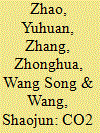|
|
|
Sort Order |
|
|
|
Items / Page
|
|
|
|
|
|
|
| Srl | Item |
| 1 |
ID:
133271


|
|
|
|
|
| Publication |
2014.
|
| Summary/Abstract |
In light of the growth in vertically specialized in global trade, the present paper uses input- output tables from the World Input-Output Database to construct an environmental multi-regional input-output model to calculate the CO2 emissions embodied in China's international trade during 1995-2009. The advantage of this model lies in its incorporation of the re-exported CO2 emissions component embodied in trade and its ability to differentiate domesticsourced CO2 emissions from foreign-sourced CO2 emissions in trade. The results show that carbon emissions embodied in both China's exports and imports increased significantly during 1995-2009. One important reason for this is that the re-exported carbon emissions embodied in China's imported intermediate inputs increased substantially during this period. Our research reveals that accelerating the transformation of trade pattern and upgrading processing trade should be emphasized in the formulation of policy to prompt CO2 emissions abatement in China.
|
|
|
|
|
|
|
|
|
|
|
|
|
|
|
|
| 2 |
ID:
161823


|
|
|
|
|
| Summary/Abstract |
This study first traces value added in gross exports of China during 2000–2014 to four components, namely domestic value added absorbed abroad (DVA), domestic value added return home (RDV), foreign value added (FVA), and pure double-counted terms (PDC), then compares these four components in China's exports with those in exports of the USA, Japan, Korea, and India. Second, this paper proposes a generalized logarithmic mean Divisia index (GLMDI) method and combines additive and multiplicative decomposition to decompose DVA gaps between China and the other four countries into value added coefficient effect, input-output structure effect, domestic scale effect and foreign scale effect. The aggregate value added coefficient effect is then attributed to sectoral level. Results show that DVA always occupied the largest share in the gross exports of China, which ranged from 74.60–82.84% during 2000–2014. Before 2011, DVA share of China's exports was generally the second smallest among five countries; since 2011, DVA share of China's exports increased, and China had the largest DVA share in 2014 (81.39%). Sectors having a large FVA share in China's exports usually had a large DVA share, such as “Mining” (MIN), “Computers, Electronic and Optical” (CEO), and “Basic Metals” (BAS). Additive and multiplicative decomposition analyses indicate that value added coefficients had a negative and increased effect on DVA gaps between China and the other four countries. Attribution analysis revealed that CEO sector had the largest negative value added coefficient effect in comparison between China and the USA, Japan, and Korea and its effect increased in comparison between China and the other four countries. Policy implications derived are finally discussed.
|
|
|
|
|
|
|
|
|
|
|
|
|
|
|
|
|
|
|
|
|